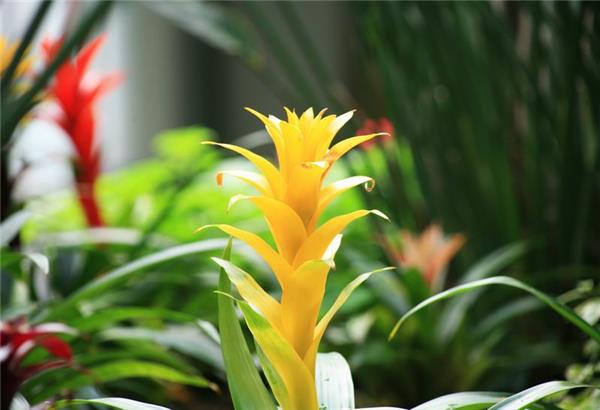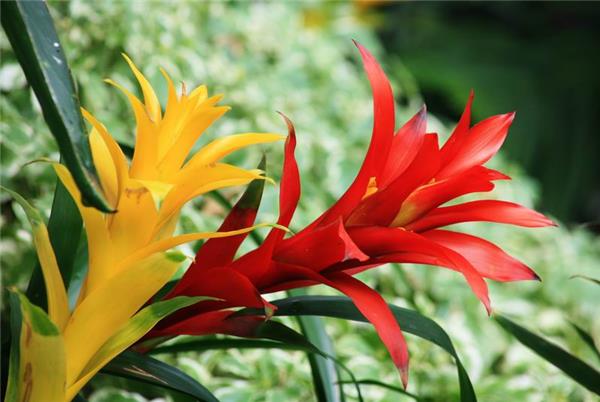Introduction of culture methods and common varieties of ornamental pineapple
Ornamental pineapple is a popular plant group in recent years, they generally have a very good or unique ornamental effect, and can be used in a variety of styles of landscape design and household style.

Culture methods of ornamental pineapple
Promoting flowering: ornamental pineapple blossoms completely naturally, must have a sufficient basis for nutritional growth, and accumulate enough nutrients for flowering. Natural flowering requires 2-3 years of cultivation time and more than 30 leaves (including fallen leaves), but it is generally difficult to bloom and the flowering time is irregular. Large-scale commercial production cultivation must use ethylene or calcium carbide water to promote flowering when the ornamental pineapple plant reaches a certain seedling age or leaf age (more than 20 leaves). Plants with strong growth potential, no disease and insect pests, up to or more than 20 leaves must be selected for pollination.
Seed collection: about 30 days after pollination, the fruit gradually expanded, the prominent sepals were dark green, and gradually turned brown with the increase of maturity, indicating that the seeds were ripe and could be harvested. The seeds should be sowed in time after harvest. If you need to store them, they can be stored in a dryer and stored in a refrigerator of 0-5 ℃.
Sowing: it is appropriate to sow seeds under sterile conditions. Sowing process: after picking the ripe but uncracked fruit, rinse the peel with clean water for 15 minutes, scrub the peel with 75% alcohol, then sterilize it with 10% hydrogen peroxide for 12 minutes, then rinse with sterile water for 3 times, cut open the fruit, take out the seeds, and sow the seeds in a solid medium, the medium is 1pm 2ms 2% sucrose + 1% activated carbon. Using this method to sow seeds, it can germinate in about a month, and the germination rate can reach more than 80%. When the true leaves of the plant grow to about 5, they can be transplanted in a bottle.

Fertilization: in order to make the ornamental pineapple grow healthily, it is necessary to apply a small amount of foliar fertilizer to the leaf tube every 1-2 weeks, such as spraying Shibao, according to the instructions on the use of foliar fertilizer and the growth of flowers.
Watering: due to the long-term storage of water in the leaf tube, the roots and leaves are easy to rot, so we should pay attention to using clean water when adding water to the leaf tube, and then use 500 times of chlorothalonil to clean the roots and leaves for a long time to prevent decay.
Diseases and insect pests: ornamental pineapple diseases and insect pests are less, but improper management will also lead to the occurrence of some diseases and insect pests. If overwatering, excessive fertilization concentration, poor substrate permeability and other prone to basic rot, you can use 50% carbendazim 800-1000 times, spray once every 7-10 days. Insect pests are mainly locusts, shell insects, thrips and heart-eating insects, which can be controlled by omethoate, Tepu water, crazy killing treasure, pink lice king and so on.
Ramet: first cut off the flower stem from the base, and then leave the leaves of the old plant 5-8 cm, and the rest are all removed, leaving the base of the leaves just to form a tube-shaped water storage, do not touch the buds when cutting. When the bud is about 10 meters high, it is gently cut from the joint between the bud and the mother plant with a sharp knife, and the small bud is planted into the basin soil made of rotten leaf soil. after careful maintenance for a year, it can blossom again.

Common varieties of ornamental pineapple
Flame pineapple: the leaves are as narrow as swords, green and shiny. From winter to early spring, bright red columnar inflorescences are extracted from the tender green leaf tube, about 30 cm high, and the terminal florets are 6-12 florets with 3 petals, yellowish green, margin blue, and turn outward after opening. When in full bloom, a string of blue-green flowers, set off by red bracts, appear particularly gorgeous and dazzling, and the viewing period can be as long as two months.
Ji pineapple: also known as small pineapple, the most suitable for potted viewing. Its leaves are strong and slender, with wavy edges, milky yellow, red or purplish red, etc., with longitudinal stripes such as crab-shaped, white or light green, born in leaf clusters, forming a disk.
Dragonfly pineapple: also known as Mei Ye Guang etc., spotted pink pineapple, the plant consists of 10-20 leaves to form a rosette-shaped leaf cluster, the base cup-shaped. The leaf tip is blunt round valgus, green, the surface is plated with a layer of silver white, the leaf surface is irregular color storage and dark green horizontal stripes and patches. Between summer and autumn, the peach-red columnar flowers are about 15 meters high. The dense flowers bloom blue at first and then turn rosy, just like a dragonfly flapping its wings, which can last for several months.

In addition, some common ornamental pineapple varieties include Phnom Penh pineapple, Caibao pineapple, Danixing and so on, which are pineapple varieties with good ornamental effect, and can be applied to soil culture and pot culture to beautify the surrounding environment and bring tropical natural scenery.
It is used to beautify the surrounding environment and bring a sense of tropical natural scenery.
Related
- Wuhan Hospital Iron Tree Blooming Result Was Instantly Frightened by the Gardener Master
- Which variety of camellia is the most fragrant and best? Which one do you like best?
- What is the small blue coat, the breeding methods and matters needing attention of the succulent plant
- Dormancy time and maintenance management of succulent plants during dormancy
- Minas succulent how to raise, Minas succulent plant pictures
- What are the varieties of winter succulent plants
- How to raise succulent plants in twelve rolls? let's take a look at some experience of breeding twelve rolls.
- Attention should be paid to water control for succulent plants during dormant period (winter and summer)
- Watering experience of twelve rolls of succulent plants
- Techniques for fertilizing succulent plants. An article will let you know how to fertilize succulent plants.



